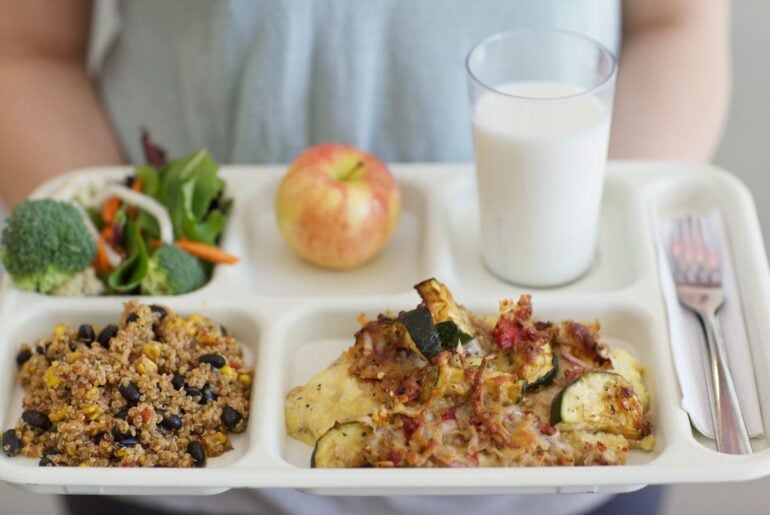Do your kids eat school meals? If so, they are part of the majority of school-aged kids across the country. Nearly 30 million students from households of all income levels eat school breakfast and lunch, getting up to half of their calories at school.
That means the quality of food served at school is paramount. It directly impacts the health and well-being of not only your kids and the adults they become, but generations of children.
Yet, most schools serve students pre-packaged, ultraprocessed foods. Not because schools want to serve kids this — most schools want to serve kids the healthiest, tastiest meals possible. But because the school food system is broken. Decades of government underinvestment left schools without the funds to buy fresh ingredients, upgrade equipment, or hire skilled culinary staff to cook hundreds to thousands of meals each day that meet federal nutrition requirements, forcing them to rely on ultraprocessed options.
Today, nearly two-thirds of a typical child’s diet is made up of ultraprocessed food. High in salt, sugars, and artificial additives with limited nutritional value, these foods are linked to lower academic performance and higher risk of chronic health conditions, including type 2 diabetes, heart disease, and depression and anxiety.
When Mara Fleishman, a mother of three in Boulder, Colorado, and CEO of the Chef Ann Foundation, joined her oldest daughter for lunch at school, she saw this firsthand. “I was shocked to see what was served. She had to return to kindergarten after lunch and tackle learning to read and write. With 30 kids in her class and one teacher, I knew these kids couldn’t eat highly processed meals and learn or sit still. That’s when I knew I had to do something.”
Improving the quality of school food is one of the most effective yet overlooked solutions for protecting children’s health.
While this involves changing a system, parents can partner with schools to improve the quality of school meals. Here’s how to begin.
Learn about how school food works
Knowledge is power! Changing school food starts with understanding how to navigate the school food system and where to focus your efforts for meaningful change.
How school food works
School food operates within a complex web of federal programs, state regulations, and local policies. The federal School Breakfast Program and the National School Lunch Program set nutritional standards, while individual districts determine what’s on the menu, where menu items and ingredients are sourced from, and what equipment is used in school kitchens.
How we got here
There’s nothing new about serving hot lunches at school. American schools have been feeding children for at least 100 years.
What started with parent-led programs in rural schools, produced mainly by volunteers (mothers), blossomed into the longest-running children’s health program in U.S. history: the National School Lunch Program.
Despite their significant impact on the health and well-being of our nation’s kids, school meal programs have been undervalued and underfunded for decades. And the people who prepare student meals remain the lowest-paid workers in most school districts, earning a median hourly wage of $12.78.
In the 1970s, ultraprocessed food corporations significantly altered diets across America, employing the same marketing tactics used by tobacco companies to sell their products to increasingly time-strapped and budget-conscious families. They marketed their salty, sugary products to kids, too.
Though most schools want to serve kids fresh, healthy meals cooked from scratch, ultraprocessed foods offered a cheap solution to serving hundreds or thousands of meals a day to students.
School food workers had to do little more than open, heat, and serve the pre-packaged foods. They no longer needed to know how to cook on a commercial scale. Over the last half-century, culinary skills among school food workers (and the general population) have gradually diminished. Commercial-scale school kitchens became outdated and were repurposed for other things.
As ultraprocessed foods came to dominate American culture and school food, dietary health problems rose.
Why quality matters
Improving school meals holds the key to healthier kids. Not only do kids learn better when they eat better, but bringing scratch cooking to schools unlocks other important academic, environmental, and community benefits — including improved student attendance and behavior, reduced food waste and carbon emissions, stronger local economies, more and better jobs, and a lifeline for food-insecure households.
Learn about what’s happening in your school
Lindsey Bradley, a food services marketing coordinator at Austin Independent School District in Texas, encourages parents to start with what they can learn on their own. “Food service teams often wear many hats, and sharing updates about their programs may not be at the top of their priority list. Research beforehand can make your first conversations more informed, positive, and productive for everyone.”
Every school participating in the School Breakfast Program and the National School Lunch Program must have a wellness policy, a document outlining the district’s approach to nutrition and student health. Most parents have never read their district’s wellness policy, but it’s one of the most important tools for understanding how decisions are made and where opportunities for change exist.
Parents should also explore their district’s food service department’s website, menus, and any of their social media accounts.
Take time to learn how your district operates so you can focus your efforts where they’ll have the most impact. Plus, you might be surprised to find that some of your ideas are already in place or in progress.
See how meals are prepared and eaten
See if your district will let you have lunch with your child. See school food through the students’ eyes. Notice who is there, what’s being served, and how they engage with it.
That’s just what parent Katie Aaron did. She volunteered at her son’s kindergarten in the Napa Valley Unified School District in California. “I began to see a socioeconomic divide at the lunch table between those who were eating school lunch and those who brought these beautiful, packed lunches from home. It took me back to my own memories of being a student who participated in the free/reduced lunch program in the 1980s. I often wouldn’t eat because back then the reduced lunch cards were a different color than everyone else, and I didn’t wanna show my card.”
If eating lunch with your child isn’t permitted, or you’d like another perspective, ask your child’s school if you can volunteer in the kitchen. Not only can rolling up your sleeves help often understaffed teams — school food staff shortages are three times greater than those for public school teachers nationwide — but you see what putting the meals together looks like and ask questions to those who know school food the most.
Often, school food professionals welcome opportunities to share about the work they do and the standards they’re required to follow. Lindsey, the school food professional from Austin Independent School District, encourages parents to be curious and ask questions. “We’re all working toward the same goals, and the best results come when we connect directly. When our team is left out of the conversation or approached with strong criticism, it can be disheartening and create greater challenges.”
Form a community advocacy group
Real change rarely happens alone. The most successful school food advocacy efforts bring together diverse community members — parents and caregivers, teachers, school nurses, and even local business representatives — who share your mission. Food service directors and school administrators can be powerful allies, so include them early as partners rather than positioning them as adversaries.
Lindsey elaborates on how having school food professionals as part of the work is invaluable: “School meal programs operate within strict federal nutrition standards, rigid purchasing regulations, and very limited budgets. Many kitchens don’t have ideal equipment, and staff may have limited culinary training, yet they work incredibly hard every day to serve hundreds of students in a short amount of time. Understanding these realities helps create more productive conversations and advocacy that supports both students and the teams who serve them.”
Aim for a core group of 5 to 10 committed people who can meet regularly. Assign rotating roles: a facilitator to guide discussions, a timekeeper, and a notetaker to document decisions. Keep meetings focused and productive by using clear agendas, adhering to 90-minute time limits, and outlining specific next steps.
Uplift school meals — and the people who prepare them
Transforming school food requires all of us — parents, policymakers, schools, and society as a whole — to change the way we think and talk about school meals and school food professionals. By changing these narratives, we can spark a movement in which we all collaborate to create a healthier future for our kids.
“Talking poorly about school meals, whether it be in your own household, on social media, or with other parents, can have a negative impact on students, especially those who rely on them,” said Austin Independent School District’s Lindsey Bradley. “Districts across the country work hard to break down the stigmas and misconceptions often associated with school meals. A crucial part of advocacy is uplifting school meals and encouraging participation. Change is more likely to occur in the future when districts have existing buy-in and the participation to support further investments.”
Getting on the ballot helped set Napa Valley up to start cooking. At the time, 19 of the 28 schools in the district didn’t have kitchens, so nothing could be cooked on-site. Food was shipped hot to the schools and sat in a hot box for hours until it was time to serve, which isn’t ideal for quality or food safety. The community supported a bond measure to update the district’s kitchens, enabling them to prepare and cook healthy food.
Anyone can change school food
Transforming school food takes time, patience, and persistence. Progress may come in small increments, but successful parent advocates will tell you it’s worth it. Every salad bar installed and scratch-cooked meal served brings our children closer to a healthier future.
“It took eight years, but the return on the time invested was worth it. Now I see the incredible lunch options in Napa Valley Unified,” shares Katie. “The kids run to the lunchroom, so excited to eat the meals. It’s a little celebration each day. The progress is more than I ever could’ve imagined.”
Parents who’ve transformed school food in their districts started where you are — with a concern for kids’ wellbeing. They learned as they went, built coalitions, and figured out how to work within their local systems. This work begins with a single conversation and a parent who believes school food matters enough to do something about it.
Want to learn more?
The Chef Ann Foundation gets schools cooking. We help schools replace ultraprocessed foods with fresh, healthy, and delicious scratch-cooked meals that protect kids and the planet. Since 2009, our programs have reached more than 16,000 schools in all 50 states, bringing better meals to 4.4 million kids. Join us.







